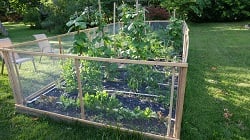
Gardening seems like it would be a simple and fruitful hobby. But there’s a reason it’s predominantly taken on by retirees. It takes far more energy, time, and maintenance than a working person can manage if it’s going to be done well. And if you’ve dedicated yourself to successful gardening, you know that protecting all those delicate plants from pests is critical. One overnight visit from a hungry deer can obliterate all your hard work, so fences are commonly used to protect them from harm. Here we’ll outline five types of garden fences you can build, and describe when each type is most appropriate.
Solid Wood or Reed Fencing. The best way to protect your produce is to prevent hungry animals from seeing it in the first place. A solid wood fence can provide a great visual and physical barrier, but it is also one of the more costly options. A slight variation on this would be a reed fence which is a thinner, more lightweight material that adds a more natural feeling to your garden.
Chicken Wire Fencing. This style of fence is lightweight and relatively easy to construct barriers using a series of small pots, even for novices. The small holes in the fencing make it ideal for keeping out mid-sized critters, and the standard three foot height is effective for deterring bunnies and raccoons. Be sure to allow the fence sides to be less tight, making it more difficult for them to crawl over the top.
High Deer Fencing. If you have a large deer population, you may want to take up golf instead of gardening. But, if you’re determined to try, be prepared for surprises. Deer are very determined and spry. For the high fence, you need a minimum height of eight feet. This can be accomplished using standard wire farm fencing, as long as it is visible enough. If you use a plastic deer fence that is intended to be less visible, tie white rags to it sporadically. The visible barrier is the true deterrent. To double the effectiveness, install the fence at a 45 degree angle slanting in the direction the deer would come from. They struggle with depth perception.
Double Deer Fencing. Doubling the fence means building a slightly shorter deer fence, maybe three feet, then surrounding it by a second three foot high fence with a three foot distance between the two. The deer are deterred by the threat of a secondary fence as they are unsure about successfully landing a jump. This type of fence can be constructed using high-tensile wire or traditional wire farm fencing.
Post and Rail Fencing. By far the most polished fencing to protect your garden is a classic post and rail. This style of fence is framed out at a 6-8’ height using pressure-treated posts with welded wire, steel hog panel fencing. It is sturdy and allows for the easy addition of a hinged door for convenient access.
No matter which type of fence is ideal for your garden situation, there are two things to keep in mind for any garden. First, always include a galvanized steel barrier anchored a foot below the ground to prevent burrowing pests from entry. Second, be sure to use a fastening system that fits the job, such as the BECK Fence Stapling System. This air-driven fence stapling system provides superior holding power along with corrosion protection for wire or wood applications. The latest addition, the gas-powered F70G, is a powerful cordless tool for countersinking fence staples into pressure treated lumber. It’s ideal for horticultural and livestock fencing ranging from light mesh to barbed wire. There is even a special attachment that allows you to attach plastic insulators for electric fence installation. No matter the fence or pest, we have the right tool to protect your produce! Download the Faster Fasteners for Fencing Whitepaper below.
.svg.png)

